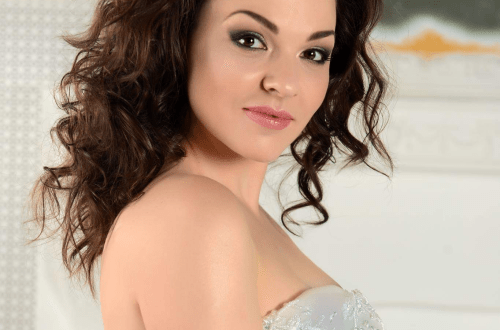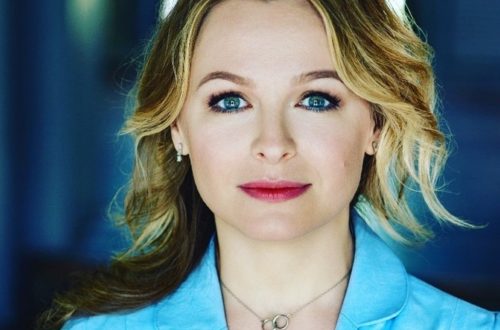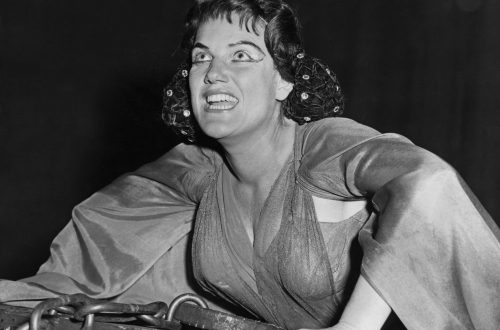
Ksenia Georgievna Derzhinskaya |
Ksenia Derzhinskaya
Half a century ago, in the June days of the distant 1951, Ksenia Georgievna Derzhinskaya passed away. Derzhinskaya belongs to the brilliant galaxy of Russian singers of the first half of the 20th century, whose art from the standpoint of today seems to us almost a standard. People’s Artist of the USSR, laureate of the Stalin Prize, soloist of the Bolshoi Theater for more than thirty years, professor at the Moscow Conservatory, holder of the highest Soviet orders – you can find a brief information about her in any domestic encyclopedic reference book, articles and essays were written about her art in previous years, and first of all, the merit in this belongs to the famous Soviet musicologist E.A. Grosheva, but in essence this name is forgotten today.
Speaking about the former greatness of the Bolshoi, we often remember her older great contemporaries – Chaliapin, Sobinov, Nezhdanova, or peers, whose art was more popularized in the Soviet years – Obukhova, Kozlovsky, Lemeshev, Barsova, Pirogovs, Mikhailov. The reasons for this are probably of a very different order: Derzhinskaya was a singer of a strict academic style, she almost did not sing Soviet music, folk songs or old romances, she rarely performed on the radio or in a concert hall, although she was famous for her subtle interpreter of chamber music, mainly concentrating on work at the opera house, left few recordings. Her art was always of the highest standard, refined intellectual, perhaps not always understandable to her contemporaries, but at the same time simple and cordial. However, no matter how objective these reasons may be, it seems that the oblivion of the art of such a master can hardly be called fair: Russia is traditionally rich in basses, she gave the world many outstanding mezzo-sopranos and coloratura sopranos, and singers of a dramatic plan on the scale of Derzhinsky in Russian history not so much vocals. “The Golden Soprano of the Bolshoi Theatre” was the name given to Ksenia Derzhinskaya by enthusiastic admirers of her talent. Therefore, today we remember the outstanding Russian singer, whose art has graced the main stage of the country for more than thirty years.
Derzhinskaya came to Russian art at a difficult, critical time for him and for the fate of the country as a whole. Perhaps her entire creative path fell on a period when the life of the Bolshoi Theater and the life of Russia, undoubtedly, influencing each other, remained, as it were, pictures from completely different worlds. By the time she began her career as a singer, and Derzhinskaya made her debut in 1913 in the opera of the Sergievsky People’s House (she came to the Bolshoi two years later), Russia was living a troubled life of a deeply ill person. That grandiose, universal storm was already on the threshold. The Bolshoi Theater in the pre-revolutionary period, on the contrary, was truly a temple of art – after decades of dominance of a second-rate repertoire, pale direction and scenography, weak vocals, by the beginning of the 20th century this colossus had changed beyond recognition, began to live a new life, sparkled with new colors, showing the world amazing samples of the most perfect creations. The Russian vocal school, and, above all, in the person of the leading soloists of the Bolshoi, reached unprecedented heights, on the stage of the theater, in addition to the already mentioned Chaliapin, Sobinov and Nezhdanova, Deisha-Sionitskaya and Salina, Smirnov and Alchevsky, Baklanov and Bonachich, Yermolenko-Yuzhina shone and Balanovskaya. It was to such a temple that the young singer came in 1915 in order to forever connect her fate with him and take the highest position in it.
Her entry into the life of the Bolshoi was swift: having made her debut on its stage as Yaroslavna, already during the first season she sang the lion’s share of the leading dramatic repertoire, participated in the premiere of The Enchantress, which was renewed after a long oblivion, and a little later was chosen by the great Chaliapin, who staged for the first time in the Bolshoi Verdi’s “Don Carlos” and singing in this performance of King Philip, on the part of Elizabeth of Valois.
Derzhinskaya initially came to the theater as a singer in the role of the first plan, although she had only one season behind her in the opera entreprise. But her vocal skills and outstanding stage talent immediately put her among the first and best. Having received everything from the theater at the very beginning of her career – the first parts, a repertoire to choose from, a conductor – a spiritual father, friend and mentor in the person of Vyacheslav Ivanovich Suk – Derzhinskaya remained faithful to him until the end of her days. The impresario of the best opera houses in the world, including the New York Metropolitan, the Paris Grand Opera and the Berlin State Opera, unsuccessfully tried to get the singer for at least one season. Only once Derzhinskaya changed her rule, performing in 1926 on the stage of the Paris Opera in one of her best roles – the part of Fevronia conducted by Emil Cooper. Her only foreign performance was a resounding success – in Rimsky-Korsakov’s opera, unfamiliar to the French listener, the singer demonstrated all her vocal skills, managing to convey to an exquisite audience all the beauty of the masterpiece of Russian musical classics, its ethical ideals, depth and originality. The Parisian newspapers admired “the caressing charm and flexibility of her voice, excellent schooling, impeccable diction, and most importantly, the inspiration with which she played the whole game, and so spent it that for four acts attention to her did not weaken for a minute.” Are there many Russian singers today who, having received such brilliant criticism in one of the musical capitals of the world and having the most tempting offers from the world’s leading opera houses, will be able not to stay in the West for at least a few seasons? Why did Derzhinskaya reject all these proposals? After all, the 26th year, not the 37th, moreover, there were similar examples (for example, the soloist of the Bolshoi Theater mezzo Faina Petrova worked for three seasons at the same New York Metropolitan Theater in the late 20s). It is difficult to unambiguously answer this question. However, in our opinion, one of the reasons lies in the fact that Derzhinskaya’s art was inherently deeply national: she was a Russian singer and preferred to sing for a Russian audience. It was in the Russian repertoire that the artist’s talent was most revealed, it was the roles in Russian operas that were closest to the singer’s creative ideal. Ksenia Derzhinskaya created a whole gallery of images of Russian women in her creative life: Natasha in Dargomyzhsky’s Mermaid, Gorislava in Glinka’s Ruslan and Lyudmila, Masha in Napravnik’s Dubrovsky, Tamara in Rubinstein’s The Demon, Yaroslavna in Borodin’s Prince Igor , Kuma Nastasya and Maria in Tchaikovsky’s operas, Kupava, Militris, Fevroniya and Vera Sheloga in Rimsky-Korsakov’s operas. These roles prevailed in the stage work of the singer. But the most perfect creation of Derzhinskaya, according to contemporaries, was the part of Lisa in Tchaikovsky’s opera The Queen of Spades. Fortunately, this work was captured for us by a recording, where Derzhinskaya sings in a duet with one of the best Hermans of the Russian stage, Nikandr Khanaev, conducted by Samuil Samosud.
Love for the Russian repertoire and the success that accompanied the singer in it does not detract from her merits in the Western repertoire, where she felt great in different styles – Italian, German, French. Such “omnivorousness”, taking into account the delicate taste, the highest culture that was inherent in the artist, and the integrity of nature, speaks of the universal nature of the singer’s vocal talent. The Moscow stage today has practically forgotten about Wagner, giving the Mariinsky Theater the lead in the construction of “Russian Wagneriana”, while in the pre-war period, Wagner’s operas were often staged at the Bolshoi Theater. In these productions, Derzhinskaya’s talent as a Wagnerian singer was revealed in an unusual way, who sang in five operas by the Bayreuth genius – Tannhäuser (Elizabeth’s part), The Nuremberg Mastersingers (Eve), The Valkyrie (Brünnhilde), Lohengrin (Ortrud), concert performance of “Tristan and Isolde” (Isolde). Derzhinskaya was not a pioneer in the “humanization” of Wagnerian heroes; before her, Sobinov and Nezhdanova had already laid a similar tradition with their brilliant reading of Lohengrin, which they cleansed of excessive mysticism and crackling heroism, filling it with bright, soulful lyrics. However, she transferred this experience to the heroic parts of Wagner’s operas, which until then were interpreted by the performers mainly in the spirit of the Teutonic ideal of the superman. The epic and lyrical beginnings – two elements, so unlike each other, were equally successful for the singer, whether it was Rimsky-Korsakov’s or Wagner’s operas. In the Wagnerian heroines of Derzhinskaya there was nothing superhuman, artificially frightening, excessively pretentious, impassively solemn and chilling the soul: they were alive – loving and suffering, hating and fighting, lyrical and sublime, in a word, people in all the variety of feelings that overwhelmed them, which is inherent in immortal scores.
In Italian operas, Derzhinskaya was a true master of bel canto to the public, however, she never allowed herself psychologically unjustified admiration for sound. Of the Verdi heroines, Aida was the closest to the singer, with whom she did not part almost throughout her entire creative life. The singer’s voice completely allowed her to sing most parts of the dramatic repertoire with large strokes, in the spirit of veristic traditions. But Derzhinskaya always tried to go from the inner psychologism of the musical material, which often led to a rethinking of traditional interpretations with the release of a lyrical beginning. This is how the artist solved “her” Aida: without reducing the intensity of passions in dramatic episodes, she nevertheless emphasized the lyricism of her heroine’s part, making its manifestation the reference points in the interpretation of the image.
The same can be said about Puccini’s Turandot, whose first performer on the Bolshoi stage was Derzhinskaya (1931). Freely overcoming the tessitura complexities of this part, fairly saturated with forte fortissimo, Derzhinskaya nevertheless tried to convey them warmly, especially in the scene of the princess’s transformation from a proud villain into a loving creature.
Derzhinskaya’s stage life at the Bolshoi Theater was happy. The singer did not know any rivals throughout almost her entire career, although the theater troupe in those years consisted mainly of outstanding masters. However, there is no need to talk about peace of mind: a Russian intellectual to the marrow of her bones, Derzhinskaya was the flesh and blood of that world, which was mercilessly eradicated by the new government. Creative well-being, which became especially noticeable in the theater in the 30s after the upheavals of the revolutionary years, when the very existence of both the theater and the genre was in question, took place against the background of the terrible events unfolding in the country. The repressions practically did not touch the Bolshoi – Stalin loved “his” theater – however, it was no coincidence that the opera singer meant so much in that era: when the word was banned, it was through their perfect singing that the best singers of Russia expressed all the sorrow and anguish that swept over their homeland , finding a lively response in the hearts of listeners.
Derzhinskaya’s voice was a subtle and unique instrument, full of nuances and chiaroscuro. It was formed by the singer quite early, so she began vocal lessons while still studying at the gymnasium. Not everything went smoothly on this path, but in the end Derzhinskaya found her teacher, from whom she received an excellent school, which allowed her to remain an unsurpassed vocal master for many years. Elena Teryan-Korganova, a famous singer herself, a student of Pauline Viardot and Matilda Marchesi, became such a teacher.
Derzhinskaya possessed a powerful, bright, pure and gentle lyric-dramatic soprano of an exceptionally beautiful timbre, even in all registers, with light, flying highs, a concentrated dramatic sonorous middle and full-blooded, rich chest notes. A special property of her voice was its unusual softness. The voice was large, dramatic, but flexible, not devoid of mobility, which, combined with a range of two and a half octaves, allowed the singer to successfully perform (and brilliantly at that) lyric-coloratura parts (for example, Marguerite in Gounod’s Faust). The singer mastered the technique of singing impeccably, so in the most difficult parts, which required increased sonority and expression, or even just physical endurance – such as Brunhilde or Turandot – she did not experience any difficulties. Particularly delightful was the singer’s legato, based on fundamental breathing, long and even, with a wide, purely Russian chant, as well as incomparable thinning and piano on extremely high notes – here the singer was truly an unsurpassed master. Possessing a powerful voice, Derzhinskaya by nature nevertheless remained a subtle and soulful lyricist, which, as we have already noted, allowed her to take place in the chamber repertoire. Moreover, this side of the singer’s talent also manifested itself very early – it was from the chamber concert in 1911 that her singing career began: then she performed in the author’s concert of Rachmaninov with his romances. Derzhinskaya was a sensitive and original interpreter of the romance lyrics by Tchaikovsky and Rimsky-Korsakov, the two closest composers to her.
After leaving the Bolshoi Theater in 1948, Ksenia Georgievna taught at the Moscow Conservatory, but not for long: fate let her go only 62 years old. She died on the anniversary of her native theater in 1951 – the year of its 175th anniversary.
The significance of Derzhinskaya’s art is in her service to her native theater, her native country, in modest and quiet asceticism. In all her appearance, in all her work there is something from the Kitezhan Fevronia – in her art there is nothing external, shocking the public, everything is extremely simple, clear and sometimes even sparingly. However, it – like an unclouded spring source – remains infinitely young and attractive.
A. Matusevich, 2001





